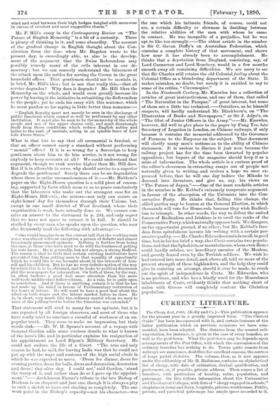CURRENT LITERATURE.
The Clergv List,1890. (Kelly and Co.)—This publication appears for the present year in a greatly improved form. "The Clerical Guide" has been incorporated with it, and certain features of the latter publication which on previous occasions we have com- mended, have been adopted. The distance from the nearest rail- way-station, for instance, is given in the case of every benefice, as well as the post-town. What the post-town may be depends upon arrangements of the Post Office, with which the convenience of the ordinary traveller has nothing to do. Towns quite remote from railways are sometimes, doubtless for excellent reasons, the centres of large postal districts. The volume, then, as it now appears under the editorship of Mr. H. Hailstone, contains an alphabetical list of clergy, with date of ordination, clerical qualification, and preferment, or, if possible, private address. Then comes a list of benefices, with particulars of locality, value, population, and patronage. On this follows information about the Universities and Theological Colleges, with lists of "clergy engaged in schools," chaplains in Army and Navy, hospitals, prisons, workhouses. Public, private, and parochial patronage has ample space accorded to it. The ecclesiastical divisions and the Cathedral establishments are given. Finally, we have directories of the Scottish Episcopal, Irish, and Colonial Churches. We have drawn from the volume some figures which interest many of our readers, though they cannot be Laken as more than approximately correct. There are, it would seem, twenty-three thousand clergy in the list. (This number does not include the clergy in Ireland, Scotland, and the Colonies.) Of these, about 9,500 are graduates of Cambridge, and about 7,700 graduates of Oxford. Dublin claims about 1,800, and Durham 1,200. London has but a small number, not much more than a hundred. This would make the proportion of University men larger than it is commonly supposed to be. The " literates " and alumni of Theological Colleges would be leas than 3,000. But this preponderance of graduates would seem to be diminishing, if we are to take the list of the deacons ordained at Christmas, 1889, as a test. Here they number, out of a total of 275, no loss than 72, or more than 25 per cent. (as against about 12 per cent, in the whole list). It may be noted that many of the Theological Colleges which send up candidates for orders are either recently founded or recently revived. A genera- tion ago, St. Aidan's and St. Bee's had almost the monopoly of non-University clerics. The number of " literates " pure and simple ordained is now very small indeed. Patronage is another interesting matter about which we may give some statistics, with the same proviso that they are not more than approximately correct. The Bishops have about 2,350 benefices in their gift between them, including a proportion of those to which they have an alternate right. The Chapters, including Westminster and Windsor (the latter having as many as 55 benefices), present to about 790. Parochial patrons—i.e, the rectors and vicars of mother- churches, taking in the Archdeacons, who have some benefices in their gift—have about 1,600. The Universities, including the governing bodies of Eton and Winchester, have the patronage of about 800 benefices. The Crown has about 160 benefices, a number which may be almost doubled, when we take into account those to which it presents alternately with the Bishops of various benefices. The Lord Chancellor presents to between 700 and 800. He has alternate or occasional rights in a few more. The plan suggested by a Royal Commission some years ago, and partially carried out, of selling the poorer benefices in the Chancellor's gift for the purpose of improving the others, has been for some time dropped. To revive it would certainly occasion no little outcry,—and rightly too. The remainder of bene- fices left in private patronage is betWeen 5,000 and 6,000. But it would be fair to deduct from these about 1,000 of which boards of trustees have control. One does not wholly admire Boards instituted to promote certain theological values. But some of the Boards are of a genuine local nature, and probably do their work well enough. The cases where benefices are made a matter of sale are probably few in number, but attain a disproportionate notoriety. They commonly change hands often. The list of "clergy engaged in schools" gives about 800 names. Eton and Winchester still retain a large clerical element, thirteen (besides two "conducts ") and ten, as against seven at Harrow.



































 Previous page
Previous page